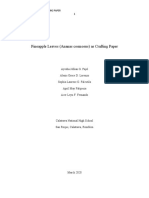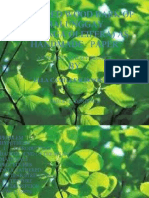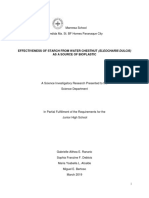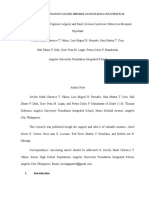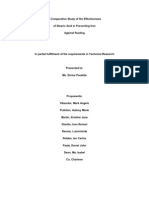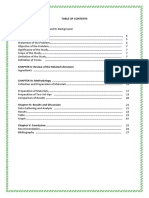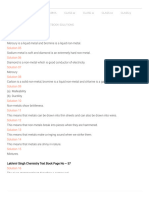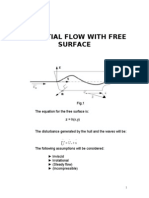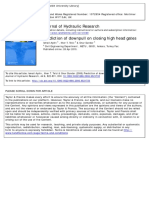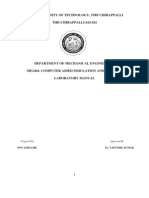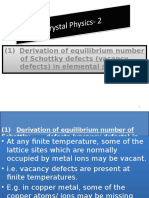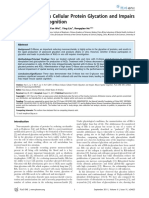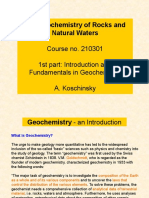Finale Research
Finale Research
Uploaded by
Jasmin RaguiniCopyright:
Available Formats
Finale Research
Finale Research
Uploaded by
Jasmin RaguiniOriginal Description:
Copyright
Available Formats
Share this document
Did you find this document useful?
Is this content inappropriate?
Copyright:
Available Formats
Finale Research
Finale Research
Uploaded by
Jasmin RaguiniCopyright:
Available Formats
Pamantasan ng Lungsod ng Maynila
College of Engineering and Technology
Department of Chemical Engineering
Nitration of Pineapple
(Ananascomosus)Leaves for the
Production of Pyroxylin Lacquer
Submitted by:
Madrial, Andrea Coleen E.
Mendoza, Marian D.
Raguini, Jasmin Fatima D.
Saya, Diana Jane S.
Submitted to:
Engr. Milagros R. Cabangon
Date of Submission:
APRIL 4, 2016
Nitration of Pineapple Leaves for the Production of Pyroxylin Lacquer 1
Pamantasan ng Lungsod ng Maynila
College of Engineering and Technology
Department of Chemical Engineering
TABLE OF CONTENTS
Introduction 3
Statement of the Problem 4
Objectives of the study 5
Significance of the study 6
Scope and limitations 7
Review of Related Literature 8
Review of Related Study 16
Methods of Reseach 17
Experimental Method 20
Process Flowchart 40
Process Diagram 41
Conclusion 42
Recommendation 43
Referecences 44
Nitration of Pineapple Leaves for the Production of Pyroxylin Lacquer 2
Pamantasan ng Lungsod ng Maynila
College of Engineering and Technology
Department of Chemical Engineering
INTRODUCTION
Pineapple leaves, though already being employed in the textile (Fitzgerald, B., 2015) and
animal feed industry in the country (Tran, 2006),are still being burned for disposal by majority of
the farmers here in the Philippines (Baconguis, S. 2014) and this method contributes to the air
pollution (Wan &Zainuddin, 2013).The outer peel or skin and core from the pineapple canning
industries, called bran, and the leaves are being utilized as feed for ruminants. However, some
researchers have reported that the leaf bracts are not considered attractive as an animal feed
because of high fiber content and soluble carbohydrates with low protein content (Correia et al.,
2004). Tagaytay City produces 4,788.70 metric tons of pineapple for the year 2009 with which
generates 383 to 478 metric tons pineapple leaf bracts (Cavite Government). One excellent way
to dispose pineapple leaf bracts, which has a cellulose content of 57.75% (The Philippines
Recommends for Pineapple, 2010), while avoiding the method of burning for disposal is to use
them as a raw material for the production of a coating material called lacquer.
Lacquer is a protective coating primarily based on nitrocellulose (cellulose nitrate) that
dries primarily by evaporation of solvent rather than oxidation of polymerization (Department of
Trade and Industry).The estimated total capacity of the lacquer manufacturers is approximately
equivalent to 250 million liter per annum. Demand for this product increased by 40 million liters
from 2013 to 2014 and is anticipated to have a continuous increase on the coming years (PAPM,
2014). However, the local supply in the market could not satisfy the mere 11% of the total
demand for 2014 and the rest of these are satisfied by importation (PAPM, 2015).
Nitration of Pineapple Leaves for the Production of Pyroxylin Lacquer 3
Pamantasan ng Lungsod ng Maynila
College of Engineering and Technology
Department of Chemical Engineering
STATEMENT OF THE PROBLEM
In 2009, Tagaytay City was able to produce 4,788.70 MT of Pineapple which
generates large amount of agricultural wastes such as pineapple leaves that is still has no proper
waste disposal management. Waste disposal is a major problem, because of very high lignin and
cellulose content of the leaves which is difficult to be degraded, thus resulting in pollution and
affecting the environment.Often times, pineapple leaves are utilized as animal feed (Tran,
2006).However, some researchers have reported that by-product of pineapple processing industry
is not considered attractive as an animal feed because of low protein content (Correiaet al.,
2004).Another way of disposal is burning the residues in an open field; however these methods
are not only ineffective but also contribute to air pollution (Wan &Zainuddin, 2013).
Burning of the pineapple leaves produces 40% of carbon dioxide (CO2), 32% of
carbon monoxide (CO), 20 % particulate matter (PM) and 50% of polycyclic aromatic
hydrocarbons. These leaves contain 57.75% cellulose (The Philippines Recommends for
Pineapple, 2010), which is important in producing lacquer that can solve the growing
demand for this product.
The demand for lacquer increased immensely by 16 percent from 2013 to 2014 and is
expected to increase in the following years (PAPM, 2014). However, local supplies cannot match
the 11 percent of the total demand that results to importation of the product (PAPM, 2015).
Nitration of Pineapple Leaves for the Production of Pyroxylin Lacquer 4
Pamantasan ng Lungsod ng Maynila
College of Engineering and Technology
Department of Chemical Engineering
OBJECTIVES OF THE STUDY
General:
To produce pyroxilin lacquer through nitration of cellulose from pineapple leaves
Specific:
To determine optimum qualities of the product by comparing the physical and chemical
properties of the standard pyroxylin lacquer
Properties Existing Proposed
Boiling Point/Range 77 C < 77%
Appearance and color Colored viscous liquid with Colored viscous liquid
strong ester odor with strong ester odor
FTIR Spectrum
Solubility Insoluble in water Insoluble in water
Table 1. Standard and Proposed PropertiesofPyroxylin Lacquer
To find out the best pre-conditioning parameters of the pineapple leaves before
undergoing chemical reaction to achieve the proposed property of pyroxylin lacquer
To determine the best operating conditions like particular alkali reagent, concentration of
reagent and most effective ratio of solution in pineapple leaves which will provide best
yield of the product
To identify the equivalent unit equipment of every laboratory process and apparatus
Nitration of Pineapple Leaves for the Production of Pyroxylin Lacquer 5
Pamantasan ng Lungsod ng Maynila
College of Engineering and Technology
Department of Chemical Engineering
SIGNIFICANCE OF THE STUDY
To the Pineapple Plantation Proprietors of Lagusan Drive, Tagaytay City
The consumption of pineapple leaves as the main raw material for lacquer production
would provide the pineapple plantation proprietors of Barangay Lagusan Drive another option
for maximizing the use of pineapple leaves instead of burning it.
To the Chemical Engineering Undergraduates and Researchers
This study can be used as a reference for undergraduate subjects related to industrial
research by chemical engineering students who will make use of pineapple leaves as their main
raw material to manufacture products related to lacquer.
To the Philippine Paint Manufacturers
Through this study, the Philippine paint manufacturers would benefit by producing
pyroxylin lacquer from pineapple leaves instead of making use of synthetic resins.In addition to
that, the manufacturers would be able to help reduce the pineapple leaf wastes.
Nitration of Pineapple Leaves for the Production of Pyroxylin Lacquer 6
Pamantasan ng Lungsod ng Maynila
College of Engineering and Technology
Department of Chemical Engineering
SCOPE AND LIMITATIONS
The study titled Nitration of Pineapple Leaves for the Production of Pyroxylin
Lacquer focuses on the use of pineapple leaves in order to produce nitrocellulose lacquer. The
digestion process in order to obtain the cellulose from the leaves was also the existing
manufacturing process which is modified to produce the same quality lacquer. The study only
covers the determination of size of the pineapple leaves, alkali to be used in the digestion
process, ratio of the solvent to the solute and the concentration of the alkali.
The researchers were able to use only limited quantities of chemicals and raw materials in
conducting the experiment; hence, the trials were only limited up to 3. It is also due to the finite
resources why the parameters in the nitration process i.e the variation of catalyst, the ratio of the
catalyst to the nitric acid and the ratio of alcohol to ether were not identified. Also, difficulty in
access to different research materials related to the study has really turned out to be a factor in
incorporating reliable sources and data. In addition, technical grade chemicals were used during
the nitration process.
The pineapple leaves prior to the experiment was not tested for its cellulose content;
hence the researchers relied to the gathered data and studies. The product was tested using the
Fourier Transform Infrared Spectroscopy (FTIR) and only the physical properties of the existing
were compared to the outcome of the research.
Nitration of Pineapple Leaves for the Production of Pyroxylin Lacquer 7
Pamantasan ng Lungsod ng Maynila
College of Engineering and Technology
Department of Chemical Engineering
REVIEW OF RELATED LITERATURE
A. RAW MATERIALS
A.1Cellulose content of Pineapple Leaves. Plant materials used for the production of
cellulose contain three main components besides from water are cellulose fibers, lignin, and
hemicellulose. The cellulose is the component needed for this research. Lignin, is a three-
dimensional polymer that binds the cellulose fibres together. Moreover, hemicelluloses are the
shorter branched carbohydrate polymers than the cellulose (Holik H., 2006).
Table2.Chemical Composition of Pineapple Fiber
Variety Moisture (%) Lignin (%) Cellulose (%) Hemicellulose (%) Others (%)
Queen 11.24 6.82 57.75 19.02 5.17
Source: (Department of Science and Technology, 2010)
According to the The Philippine recommends Pineapple of the Depart of Science and
Technology, pineapple leaves has the following chemical composition. The researchers used the
Queen type of pineapple which according to Table 2 has 11. 24% of moisture. With this
information, drying of the leaves was bypassed. The pineapple leaves having high cellulose
content, 57.75%, would be efficient for producing pyroxylin.
Based from the article, A Review on Pineapple Leaves Fibre and Its Composites (Asim et. al..,
2015), pineapple leaf consist of 11.8% of moisture. Its cellulose content is ranging from 60-72%
and a lignin content of 5-11%. This information acquired from an international journal, though
having small increments, supports the above citation of chemical composition of pineapple leaf.
Nitration of Pineapple Leaves for the Production of Pyroxylin Lacquer 8
Pamantasan ng Lungsod ng Maynila
College of Engineering and Technology
Department of Chemical Engineering
A.2Cellulose content of Pineapple Leaves compared to other Agricultural waste.
Table3. Comparison of Cellulose Content
Type Moisture (%) Lignin (%) Cellulose (%) Hemicellulose (%) Others (%)
Pineapple 11.24 6.82 57.75 19.02 5.17
leaf [1]
Sugar Cane 10.32 20.50 28.75 12.28 28.15
Bagasse [2]
Coconut 15.00 24.93 20.29 7.23 32.55
Husk [3]
Sources: [1] Department of Science and Technology, 2010 [2] Manalo, et. al.., 1992 [3]
Tejano, E.A, 1985 [4]
Philippines being an agricultural country produces tons of agricultural crops. Most of the
common are coconut husk and sugar cane bagasse. Philippines is also one of the top producers of
tropical fruits and plants such as pineapple. The waste from this plants and crops can be
converted into a useful product. Cellulose can be extracted from this agricultural waste. Table 3
shows the composition of cellulose in the fibers of sugar cane bagasse, coconut husk and
pineapple leaf.
The researchers made use of pineapple leaves among the two top leading agricultural waste in
the country because of its high cellulose content.
A. 2 Production of Pineaappine in Tagaytay. Pineapple is considered one of the
commercially important plants in the province since it has helped increase the income of most
municipalities in the province like Silang, Indang, Alfonso and Tagaytay City, its major
producers. Tagaytay alone produces 4,778.70 MT of pineapple.
Nitration of Pineapple Leaves for the Production of Pyroxylin Lacquer 9
Pamantasan ng Lungsod ng Maynila
College of Engineering and Technology
Department of Chemical Engineering
Table 4: Pineapple Production by City/Municipality, Province of Cavite: 2009
City / Municipality Production (Metric Tons)
District VII
Tagaytay City 4,778.70
Source: Office of the Provincial Agriculturist, TreceMartires City (2009)
A. 3. Utilization of Pineapple leaves
Frequently, pineapple leaves are utilized as animal feed (Tran, 2006).However, some
researchers have reported that by-product of pineapple processing industry is not considered
attractive as an animal feed because of low protein content (Correiaet al., 2004).Another way of
disposal is burning the residues in an open field; however these methods are not only ineffective
but also contribute to air pollution (Wan &Zainuddin, 2013).
A. 4. Effects of Pineapple leaf burning
According to the Commission for Environmental Cooperation,It is estimated that burning
biomass, such as wood, leaves, trees and grassesincluding agricultural wasteproduces 40%
of carbon dioxide (CO2), 32% of carbon monoxide (CO), 20% of particulate matter (PM), and
50% of polycyclic aromatic hydrocarbons (PAHs) released into the environment around the
globe. Although agricultural waste burning is not an environmentally acceptable form of
agricultural management, it is a frequent practice and is worrisome from a public health
viewpoint for a number of reasons.
Nitration of Pineapple Leaves for the Production of Pyroxylin Lacquer 10
Pamantasan ng Lungsod ng Maynila
College of Engineering and Technology
Department of Chemical Engineering
A. 4. Pineapple Leaf Related
According to Benjamin Fitzgerald, as couture bites into fruit as a source of natural fiber, the
amount of pia used in textiles is steadily growing across North America. Pia importer Ecossar,
is just one textile firm working directly with local artisans in The Philippines, to spread pia's
reach. More designers need to experience the luxury of this fruit-based thread, completely
derived from pineapple leaves.
B. Processes
B.1 Alkali Digestion
Alkali digestion is a process that extracts fibrous material, cellulose. The purpose of
alkali digestion is to liberate cellulose fibers from other chemicals and impurities in the fibrous
source. Alkali digestion uses lye (a caustic soda) to remove lignin from fibrous source. (Sixta&
Herbert, 2006)
B.2 Nitration Process. Nitration is a broad class of chemical process for the introduction
of a nitro group into an organic chemical compound (Booth, 2012) For this process, nitric acid is
the main reagent used the addition of a nitro group, usually to an organic molecule. Also
commonly used as a strong oxidizing agent (Zumdahl, S., 2009). Usual nitration syntheses apply
so-called "mixed acid", a mixture of concentrated nitric acid and sulfuric acids. Sulfuric acid is
not required to nitrate the cellulose but acts as a catalyst to produce nitronium ion, NO2+, and
acts as an absorbent for water (McMurry, J., 2007)
Nitration of Pineapple Leaves for the Production of Pyroxylin Lacquer 11
Pamantasan ng Lungsod ng Maynila
College of Engineering and Technology
Department of Chemical Engineering
The first step of nitration is to activate nitric acid with sulfuric acid to produce a stronger
electrophile, the nitronium ion. Because the nitronium ion is a good electrophile, it is attacked by
cellulose to produce Nitrocellulose. (Clark, 2000)
Nitrocellulose is a highly flammable compound formed by nitrating cellulose through
exposure to nitric acid or another powerful nitrating agent. (Merck Index, 2013)
Two parts of concentrated sulfuric acid and one part of concentrated nitric acid is needed.
When acids are mixed, a lot of heat is produced, and the mixture needs to be cooled. The mixture
of these two acids is called a nitrating acid mixture. After acids are mixed, add there cellulose.
After 15 minutes, cellulose is nitrated. It should then be rinsed with water to get rid of the acid
residues and baking soda will be added for neutralization. (Thoisoi, 2014)
10% concentration of sodium bicarbonate solution is suggested. (TAPPI Standards)
3HNO3 +C6H10O5C6H8(NO2)2O5+ 3H2O
Fig. 1.The actual nitrating agent in nitration of aromatic compounds is the nitronium ion, NO2 +
derived from nitric acid by the action of sulfuric acid
Nitration of Pineapple Leaves for the Production of Pyroxylin Lacquer 12
Pamantasan ng Lungsod ng Maynila
College of Engineering and Technology
Department of Chemical Engineering
According to Prof. Steve Dessens of Houston Community College, when you mix pure
sulfuric acid with concentrated nitric acid (about 70% HNO3 in water), you are diluting the
H2SO4 just as if you were mixing it with water, which, you'll recall, is a very exothermic
process in which a weakly-held hydogen ion from H2SO4 is transferred to a water molecule,
forming hydronium ion, H3O+. Thus the old rule, "Add Acid" for sulfuric acid, meaning you
should slowly add the acid to the water instead of the water to the acid, to help prevent the
danger of sudden boiling and splattering of hot acid. Keeping things cool helps prevent this
overheating.
If you are mixing only a few milliliters of concentrated H2SO4 and HNO3, the amount of
heat released will not be so great, so a water bath at room temperature is normally adequate to
ensure that overheating does not occur. You can even do the mixing in a small graduated
cylinder with no water bath. But larger volumes are often mixed at ice bath temperatures just to
be on the safe side.
Aromatic nitrations easily result in "over-nitration" to form dinitrated products and/or
decomposition products if the reaction gets out of hand. This problem is lessened if the reaction
is done at lower temperature. Nitrations are also exothermic reactions, so in the absence of a
cold water bath, the increase in temperature could cause the reaction to get out of control.
Nitration of Pineapple Leaves for the Production of Pyroxylin Lacquer 13
Pamantasan ng Lungsod ng Maynila
College of Engineering and Technology
Department of Chemical Engineering
B.3 Neutralization
The reaction of acids with sodium bicarbonate is a common method for neutralizing acid
spills. The advantage to this method is that one can use excess sodium carbonate, which is
relatively innocuous. The neutralization process is signaled by the release of gaseous CO2The
sodium bicarbonate is an alkali and will neutralize much of the acid remaining (Powell, 2009)
NaHCO3 is a salt which consists of the ions Na+ and the bicarbonate anion, HCO3-. In
aqueous solution, these ions are separated. Furthermore the bicarbonate anion forms some
hydroxide, which results in its solutions being mildly alkaline (Robert, 2007)
(HCO3-)CO2+OH-
CO2 + 2NaOH Na2CO3 + H2O
B.4 Dissolutionof Nitrocellulose.
In a book, Practical Herbs 2 by Henriette Kress (an active online book since 1995).
Pyroxylin consists of dinitro-cellulose, C6H8(NO2)2O5 which is soluble in a mixture of alcohol
and ether. Alcohol is commonly used in the dissolving nitrocellulose.
For this research study, ethanol and petroleum ether which are forms of alcohol and ether
were used to dissolve the dinitro-cellulose.
C. Lacquer
C.1 Definition. According to the Department of Trade and Industry, lacquer is defined as
a coating that dries primarily by evaporation rather than by oxidation or polymerization. Because
Nitration of Pineapple Leaves for the Production of Pyroxylin Lacquer 14
Pamantasan ng Lungsod ng Maynila
College of Engineering and Technology
Department of Chemical Engineering
the solvents or water used in lacquers are relatively volatile and no chemical change is required
for formation of the film, lacquers dry very rapidly.
According to PHARMACOPEIA, pyroxylin lacquer contains not less than 5.0% and not
more than 14%, by weight, of pyroxylin. Ether to alcohol ratio is 3:1.
C.2 Pyroxylin manufacture and applications
According to Walter Field, the term pyroxylin is understood the soluble nitric ethers of
cellulose, namely the di, tri, tetra, and penta-nitrates. From the date of the use of pyroxylin in
photography by Scott Archer in 1851, the number of its uses has increased until, at present time,
tons of the lower nitrates of cellulose are produced yearly.
In the form of celluloid it is before us constantly. As a varnish it is used on penholders,
pencils, silver and brass ware. Articles are bronzed with it as a medium. An artificial leather has
been produced with it. These applications are all made, with the exception of celluloid, by the
use of a solution of pyroxylin.
C.1 INDUSTRY PROFILE
According to the Philippine Association of Paint Manufacturers, the estimated total
capacity of the lacquer manufacturers is approximately equivalent to 250 million liter per annum.
With a volume forecast that expected to expand a modest 8-9% annual rate. In addition, a 16%
annual rate growth is forecast for demand in architectural coatings as building activity expands
and the economy grows at a modest rate from 2013 to 2014.
Nitration of Pineapple Leaves for the Production of Pyroxylin Lacquer 15
Pamantasan ng Lungsod ng Maynila
College of Engineering and Technology
Department of Chemical Engineering
REVIEW OF RELATED STUDIES
1. Non-wood fibers for Rayon Grade High Alpha Pulp
Author: P.C. Francia, L.D. Belen, E.U. Escolano, and E.P. Villanueva
Fresh solution of pulping liquor with known concentration of active alkali was added. Abaca and
bagasse were cooked for 90 min; pineapple 60 min. Rise in temperature from 100 C to 170 C
Table 5: Cellulose components of Abaca, Bagasse and Pineapple leaves
Raw Material %Holocellulose %Alphacellulose %ash %lignin
ABACA
Grade S2 S3 88.1 64.1 0.6 8.8
Grade I, G, H 86.4 58.6 0.9 10.2
Bagasse 74.6 42.4 1.2 9.8
Depithed
Bagasse 71.5 - 2.39 20.5
Whole
Pineapple leaves 25.2 23.7 6 2.6
Source: FPRDI DOST
For the trial testing of the soda pulping, the researchers used 60 minutes as the base pulping time
for the experiment with a maximum temperature of 150 C.
2. Pulp and Paper Production from Nigerian Pineapple Leaves and Corn Straw as
Substitute to Wood Source
Author: Aremu, M., Rafiu, M., &Adedeji, K
Pulping of chipped pineapple leaves and corn straw was achieved using chemical pulping
method (soda pulping). About 200g of the raw material (oven-dry weight) was loaded into a
1000ml conical flask which was then placed in a pressure pot containing sufficient amount of
water. 42 g of pulping chemical (caustic soda) was dissolved in 600 ml of water (7% sodium
Nitration of Pineapple Leaves for the Production of Pyroxylin Lacquer 16
Pamantasan ng Lungsod ng Maynila
College of Engineering and Technology
Department of Chemical Engineering
hydroxide) and the solution was poured into the conical flask. The ratio of volume of water to the
weight of raw material was 3:1. Pulping time was 180 mins (3hrs).
Similarly, the ratio of the solvent to solute was adapted and the lower range is 2:1.
However, it is not possible because the pineapple leaves will not be submerged in the solution
thats why 2.5:1 is chosen instead.
METHODS OF RESEARCH
The experimenters conducted extensive research in order to have a comprehensive study
through experimentation for the analysis of the properties and characteristics of raw materials
and product. Different methods of research were used to obtain vital information and data for the
study. The methods are the following:
I. Descriptive Method
This method consists of the collection of qualitative and quantitative information
about the study such as related literatures and studies from different books, articles, and
journals. Local and international articles from different institutional and organizational
websites in relation to production and processing of lacquers from pineapple leaves were
collected by the researchers.The gathered data undergone intense analysis and was
summarized to be included in the review of related literature.
The researchers gathered the information for the availability and demand of pineapple
leaves and lacquer from different government institutions and electronic sources. As well
as the factual information for the description and properties of the raw materials. The
following are:
National Statistics Office (NSO) Ramon Magsaysay, Sta. Mesa, Manila
- Provided the data for the availability and demand of pineapple and
lacquer.
Nitration of Pineapple Leaves for the Production of Pyroxylin Lacquer 17
Pamantasan ng Lungsod ng Maynila
College of Engineering and Technology
Department of Chemical Engineering
Department of Science and Technology (DOST) Bicutan, Taguig City
- Science and Technology Information Institute Library of DOST
provided factual information of the raw materials and desired product.
Also, journals for the pulping and nitration process was gathered from
here.
National Library of the Philippines Kalaw, Ermita, Manila
- Information from books and articles about the raw material was
gathered.
Pamantasan ng Lungsod ng Maynila Library Intramuros, Manila
- Provided information for some terms used in the research.
Chemical Engineering Websites
- The researchers made used of internet for international and local
studies which include journal websites and portable document format
(PDF). Some of these websites are Science Direct, EBSCO, ScoPus,
and other academic sites.
II. Experimental Method
This method includes the detailed information and processes for the production of
nitrocellulose lacquer based from the gathered data in the review of related literature.
This method of research scientific undertaking was done through laboratory set-up for
experimentations. Various parameters were considered to come up the best quality of the
product which were anchored by the related studies and literature that was analyzed by
the researchers.
The experimental method was done at through the following:
Adamson University Laboratory San Marcelino St., Ermita, Manila
- Provided the laboratory space and apparatus for the experiment. They
also provided the product testing through FT-IR Spectroscopy.
Sta. Cruz, Manila
Nitration of Pineapple Leaves for the Production of Pyroxylin Lacquer 18
Pamantasan ng Lungsod ng Maynila
College of Engineering and Technology
Department of Chemical Engineering
- One of the researchers home provided further observation and
improvement of the product.
Nitration of Pineapple Leaves for the Production of Pyroxylin Lacquer 19
Pamantasan ng Lungsod ng Maynila
College of Engineering and Technology
Department of Chemical Engineering
EXPERIMENTAL METHOD
The experimentation was done in a laboratory scale. In order to produce the desired product,
variation of parameters such as size, alkali reagent, concentration of alkali reagent, and ratio of
liquor to raw material were observed.
A. Collection and Preparation of Raw Material
The raw material used which is the pineapple leaves are gathered and collected from
Barangay Lagusan Drive, Tagaytay City.
In this process, the pineapple leaves will undergo size reduction. From the study
Chemical Analysis and Pulping Study of Pineapple Crown Leaves, the leaf samples were cut into
pieces of 5 cm in length. This study was used by the researchers to set the parameter in the size
reduction of the pineapple leaves.
A.1 Size Reduction of Pineapple Leaves
a. Apparatus and Materials
scissors
Pineapple
leaves
Figure 9.1 Size Reduction of Pineapple Leaves
b. Objective
To determine the optimum size of pineapple leaves that will give a best yield for
alkali digestion process
c. Hypothesis
The smaller the size of the pineapple leaves, the faster the rate of reaction.
Nitration of Pineapple Leaves for the Production of Pyroxylin Lacquer 20
Pamantasan ng Lungsod ng Maynila
College of Engineering and Technology
Department of Chemical Engineering
d. Procedure
1. Measure and cut the pineapple leaves into 5 cm in length.
2. Weigh 150 grams of pineapple leaves and place it in 1-L beaker.
3. Pour450g of 10% NaOH solution to the 1-L beaker containing the
pineapple leaves.
4. Heat the pineapple leaves until it reaches 100C and digest for 60 minutes
after boiling.
5. After digesting, let it cool for 10 minutes.
6. Separate the pulp from black liquor and wash the pulp with 1-L water.
7. Dry the washed pulp for 15 minutes at 100C.
8. Weigh the obtained pulp and record.
9. Repeat steps 2-9 using 7 cm and 9 cm in length pineapple leaves.
Figure 9.2 Alkali digestion of size reduced pineapple leaves
e. Data and Results
Table 9.1 Determination of the Optimum Size of Pineapple Leaves
Parameter Trial 1 Trial 2 Trial 3
Mass of Pineapple Leaves (g) 150.00 150.00 150.00
Size 5 cm 7 cm 9cm
Amount of White Liquor (g) 450 450 450
Temperature () 100 100 100
Time (min) 60 60 60
Nitration of Pineapple Leaves for the Production of Pyroxylin Lacquer 21
Pamantasan ng Lungsod ng Maynila
College of Engineering and Technology
Department of Chemical Engineering
Mass of Dried Pulp (g) 75.05 85.52 80.49
Percent Yield (%) 65.17 74.27 69.90
Percent Mass Removed (%) 34.83 25.73 30.10
f. Calculations:
PERCENT YIELD:
150 g leaves (0.5775+0.1902) = 115.155 g of cellulose
=
Trial 1: 5cm
.
= .
.
Trial 2: 7cm
.
= .
.
Trial 3: 9cm
.
= .
.
g. Analysis
The optimum size for the pineapple leaves was determined through alkali
digestion. Based on the Table 9.1, more mass is removed when the size is shorter because
the leaves are completely soaked and exposed to the solution compared to the leaves with
longer length. Thus, the size of 5 centimeter was chosen to be the optimum size for
pineapple leaves.
Nitration of Pineapple Leaves for the Production of Pyroxylin Lacquer 22
Pamantasan ng Lungsod ng Maynila
College of Engineering and Technology
Department of Chemical Engineering
h. Conclusion
The optimum size for the pineapple leaves is 5 cm in length since it is completely
immersed in the liquor thus, yielding the highest percent of mass removed of 34.83%.
i. Equivalent Equipment
Laboratory Scale Plant Scale
Scissors Rotary Knife Cutter
B. Alkali Digestion Process of Pineapple Leaves
Pineapple leaves are digested in an alkali solution in order to obtain the cellulose which is
needed for the production of pyroxylin lacquer. The parameters such as the alkali reagent,
concentration of alkali reagent and ratio of alkali reagent to pineapple leaves are tested and the
remaining parameters and held constant.
B.1 Determination of the Optimum Alkali Reagent for Pulping
a. Apparatus and Materials
Pineapple Leaves Sodium Hydroxide
Vials Calcium Hydroxide
Thermometer Potassium Hydroxide
Stirring Rod Analytical Balance
Pipette Aspirator
1-L Beakers Hot Plate
b. Objective
To determine the optimum alkali reagent for alkali digestion
Nitration of Pineapple Leaves for the Production of Pyroxylin Lacquer 23
Pamantasan ng Lungsod ng Maynila
College of Engineering and Technology
Department of Chemical Engineering
c. Procedure
1. Weigh 150 g of pineapple leaves and place it in a 1-L beaker.
2. Pour10% concentration of NaOH solution in the beaker containing
pineapple leaves.
3. Heat the pineapple leaves until it reaches 100C and digest for 60 minutes
after boiling.
4. After digesting, let it cool for 10 minutes.
5. Separate the pulp from black liquor and wash the pulp with 1-L water.
6. Dry the washed pulp for 15 minutes at 100C.
7. Weigh the obtained pulp and record.
8. Repeat steps using saturated Ca(OH)2 solution and 13% KOH.
d. Data and Results
Table 9.2. Determination of the Optimum Alkali Reagent
Parameter Trial 1 Trial 2 Trial 3
Mass of Pineapple Leaves (g) 150 150 150
Alkali Reagent NaOH Ca(OH)2 KOH
Amount of White Liquor (g) 450 450 450
Temperature () 100 100 100
Time (min) 60 60 60
Mass of Dried Pulp (g) 75.05 Using calcium 74.37
hydroxide as
Percent Yield (%) 65.17 an alkali 64.58
reagent did not
digest the
pineapple
leaves. After
30 minutes of
Percent Mass Removed (%) 34.83 35.42
digesting, the
leaves are still
in its
rectangular
shape.
Nitration of Pineapple Leaves for the Production of Pyroxylin Lacquer 24
Pamantasan ng Lungsod ng Maynila
College of Engineering and Technology
Department of Chemical Engineering
Figure 9.3 Determination of Alkali Reagent. (L-R) KOH, NaOH, Ca(OH)2
e. Calculations:
150 g leaves (0.5775+0.1902) = 115.155 g of cellulose
PERCENT YIELD:
=
Trial 1: NaOH
.
= .
.
Trial 3: KOH
.
= .
.
f. Analysis
Table 9.2 shows that using Ca(OH)2 as an alkali reagent for alkali digesting is
ineffective. The pineapple leaves does not react well with Ca(OH)2 compared to the other
two being used and as a result, it does not change its rectangular shape as shown in
Figure 9.3. Between NaOH and KOH, the former is chosen because the difference in
percent mass removed between the two alkali reagents is 0.59 which is insignificant.
Nitration of Pineapple Leaves for the Production of Pyroxylin Lacquer 25
Pamantasan ng Lungsod ng Maynila
College of Engineering and Technology
Department of Chemical Engineering
g. Conclusion
The optimum alkali reagent for the alkali digestion process of pineapple leaves is
NaOH having the significant percent mass removed of 34.83%.
h. Equivalent Equipment
Laboratory Scale Plant Scale
Beaker Batch Reactor
B.2 Determination of the Concentration of Sodium Hydroxide Reagent (NaOH)
According to the Technical Association of the Pulp and Paper Industry (TAPPI),
the standard concentration of sodium hydroxide for alkali digestion is 10% w/w. From here,
the researchers varied the determination of concentration of sodium hydroxide to 7%, 10%
and 13% w/w.
a. Apparatus and Materials
Thermometer
1-L beaker
Sodium
hydroxide
Pineapple solution
leaves
Figure 9.4 Determination of Concentration of Sodium Hydroxide
Nitration of Pineapple Leaves for the Production of Pyroxylin Lacquer 26
Pamantasan ng Lungsod ng Maynila
College of Engineering and Technology
Department of Chemical Engineering
b. Objective
To determine the optimum concentration of sodium hydroxide
c. Hypothesis
The concentration of sodium hydroxide must be low in order to avoid cellulose
degradation
d. Procedure
1. Weigh 150 g of 5 cm in length pineapple leaves and place it in a 1-L
beaker.
2. On a separate beaker, dissolve 100 g of NaOH pellets in 1-L water to
produce 7% concentration. Carefully stir to dilute.
3. Mix the NaOH solution in the 1-L beaker containing pineapple leaves.
4. Heat the pineapple leaves until it reaches 100C. Cook it for 60 minutes
after boiling.
5. After digesting, let it cool for 10 minutes.
6. Separate the pulp from black liquor and wash the pulp with 1-L water.
7. Dry the washed pulp for 15 minutes at 100C.
8. Weigh the obtained pulp and record.
9. Repeat steps using 10% and 13% concentration of NaOH.
e. Data and Results
Table 9.3Determination of the Concentration of Sodium Hydroxide Reagent (NaOH)
Parameter Trial 1 Trial 2 Trial 3
Mass of Pineapple Leaves (g) 150 150 150
Concentration of NaOH (% w/w) 7 10 13
Amount of White Liquor (g) 450 450 450
Temperature () 100 100 100
Time (min) 60 60 60
Nitration of Pineapple Leaves for the Production of Pyroxylin Lacquer 27
Pamantasan ng Lungsod ng Maynila
College of Engineering and Technology
Department of Chemical Engineering
Mass of Dried Pulp (g) 79.70 75.05 68.67
Percent Yield (%) 69.21 65.17 59.63
Percent Mass Removed (%) 30.79 34.83 40.37
f. Calculations:
PERCENT YIELD:
Trial 1: 7%
.
= .
.
Trial 2: 10%
.
= .
.
Trial 3: 13%
.
= .
.
g.Analysis
After the alkali digestion process, the optimum alkali reagent concentration is
identified to be 10%. Table 9.3 shows that as the concentration of the alkali reagent
increases, the percentage of mass removed also increases. However, the mass of dried
pulp obtained in 13% concentration is much lower than 10%. Thus, the 10%
concentration which yield a percent mass removed of 34.83% and which is considered.
h. Conclusion
The optimum concentration of NaOH is 10% by weight which yield the second to
the highest percentage of mass removed of 34.83%.
Nitration of Pineapple Leaves for the Production of Pyroxylin Lacquer 28
Pamantasan ng Lungsod ng Maynila
College of Engineering and Technology
Department of Chemical Engineering
i. Equivalent Equipment
Laboratory Scale Plant Scale
Beaker Batch Reactor
B.3 Determination of the Ratio of Alkali Reagent to Raw Material
The determination of ratio of alkali reagent to pineapple leaves is set to be 2.5:1, 3:1,
and 4:1. The researchers based the variation of ratio from the study Pulp and Paper
Production from Nigerian Pineapple Leaves and Corn Straw as Substitute to Wood
Source(Aremu et al., 2015)wherein the ratio of the alkali reagent to pineapple leaves is 3:1.
The lower range must be 2:1 for consistency. However, the use of such ratio do not fully
immerse the pineapple leaves into the solution, thus, having 2.5:1 as an option.
a. Apparatus and Materials
thermometer
1-L beaker
Figure 9.5 Determination of the Ratio of Liquor to Raw Material
b. Objective
To determine to appropriate ratio of the liquor to the pineapple leaves
c. Procedure
1. Weigh 150 g of 5 cm in length pineapple leaves and place it in a 1-L
beaker.
Nitration of Pineapple Leaves for the Production of Pyroxylin Lacquer 29
Pamantasan ng Lungsod ng Maynila
College of Engineering and Technology
Department of Chemical Engineering
2. Mix 375 g of 10% NaOH solution in the 1-L beaker containing pineapple
leaves.
3. Heat the pineapple leaves until it reaches 100C. Cook it for 60 minutes
after boiling.
4. After digesting, let it cool for 10 minutes.
5. Separate the pulp from black liquor and wash the pulp with 1-L water.
6. Dry the washed pulp for 15 minutes at 100C.
7. Weigh the obtained pulp and record.
8. Repeat steps using 450 g and 600 g amount of 10% NaOH solution.
d. Data and Results
Table 9.4 Determination of the Ratio of Liquor to Raw Material
Ratio of NaOH to Pineapple Leaves
Parameter 2.5:1 3:1 4:1
Mass of Pineapple Leaves (g) 150 150 150
Concentration of NaOH (% w/w) 10 10 10
Amount of White Liquor (g) 375 450 600
Temperature () 100 100 100
Time (min) 60 60 60
Mass of Dried Pulp (g) 75.24 75.05 53.50
Percent Yield (%) 65.34 65.17 46.46
Percent Mass Removed (%) 34.66 34.82 53.54
e. Calculations:
PERCENT YIELD:
=
Trial 1: 7%
Nitration of Pineapple Leaves for the Production of Pyroxylin Lacquer 30
Pamantasan ng Lungsod ng Maynila
College of Engineering and Technology
Department of Chemical Engineering
.
= .
.
Trial 2: 10%
.
= .
.
Trial 3: 13%
.
= .
.
f. Analysis
150 grams of feed is digested using different ratio of alkali reagent specifically
2.5:1, 3:1, and 4:1. Setting all other parameters constant except for the ratio of the alkali
reagent, the best ratio is determined. As shown in Table 9.4, there is a small increment
between 2.5:1 and 3:1 ratios that is why the former is considered to be the optimum ratio.
g. Conclusion
The optimum ratio of the alkali reagent to the pineapple leaves is determined to be
2.5:1.
h. Equivalent Equipment
Laboratory Scale Plant Scale
Beaker Batch Reactor
Table 9.6Summary of Parameter for Alkali Digestion
SUMMARY OF PARAMETERS FOR ALKALI DIGESTION
Amount of Initial Mass 150 g
Size of Pineapple Leaves 5 cm
Concentration of NaOH 10%
Ratio of NaOH Soln. to Pineapple leaves 2.5:1
Amount of White Liquor 375g
Temperature for Digesting 100
Time for Digesting 60 min
Nitration of Pineapple Leaves for the Production of Pyroxylin Lacquer 31
Pamantasan ng Lungsod ng Maynila
College of Engineering and Technology
Department of Chemical Engineering
C. Nitration
Nitration is a broad class of chemical process for the introduction of a nitro group into an
organic chemical compound (Booth, 2012). As reported by Pharmacopeia, pyroxylin lacquer
contains not less than 5.0% and not more than 14%, by weight, of pyroxylin. Ether to alcohol
ratio is 3:1. Moreover, according to Professor Steve Dessens of Houston Community College,
mixing only a few milliliters of concentratedH2SO4and HNO3, the amount of heat released will
not be so great, so a water bath at room temperature is normally adequate to ensure that
overheating does not occur. You can even do the mixing in a small graduated cylinder with no
water bath. But larger volumes are often mixed at ice bath temperatures just to be on the safe
side.
a. Apparatus and Materials
b. Procedure
1. Mix 40 ml of 63% Nitric Acid and 120 ml of 94% Sulfuric Acid in a
beaker.
2. Place the beaker in a water bath full of ice. Stir the mixture until it reaches
0C.
3. Weigh 40 g of cellulose pulp and mix it with the nitric and sulfuric acid
solution in the beaker.
Nitration of Pineapple Leaves for the Production of Pyroxylin Lacquer 32
Pamantasan ng Lungsod ng Maynila
College of Engineering and Technology
Department of Chemical Engineering
4. Stir the slurry for 10 minutes to provide time for the reaction to produce
nitrocellulose.
5. Separate the filter cake containing the nitrocellulose from the mixture.
6. Soak the filter cake with 500 mL of water for 5 minutes.
7. Neutralize the nitrocellulose pulp by soaking the washed pulp to a 10%
sodium bicarbonate solution for 5 minutes. Gradually stir.
8. Filter the pulp from the solution then, flatten it in a filter paper pressing it
with another filter paper above to remove excess moisture.
9. Blow dry it with cool air for 10 minutes.
10. Using the flammability test, ignite the pulp with fire to prove if it is a
nitrocellulose. If the pulp ignites rapidly and leaves no residue, then it is a
nitrocellulose.
11. Another testing is to dissolve the solution with petroleum ether and
ethanol. Dissolve the 10 g of nitrocellulose with 10g of petroleum ether
and 30g of ethanol.
12. Repeat steps except procedure no. 2.
c. Data and Results
Table 9.7 Nitration Process
Parameter Trial 1 Trial 2
Pulp (g) 40 40
Ratio of Sulfuric Acid to Nitric Acid 3:1 3:1
Temperature () 80 0
Time (min) 30 30
Mass of Dried Pulp (g) 2 27
Percent Yield (%) 5.00 67.5
Nitration of Pineapple Leaves for the Production of Pyroxylin Lacquer 33
Pamantasan ng Lungsod ng Maynila
College of Engineering and Technology
Department of Chemical Engineering
d. Calculations:
PERCENT YIELD:
=
Trial 1: 7%
= %
Trial 2: 10%
= . %
e. Analysis
On table 9.7, trial 2 was chosen against trial 1 since the percent yield is much higher
which amounts to 67.5 percent. Also, the yielded dried pulp is higher compared to trial 1
which has only 2 grams of dried pulp. Temperature difference also plays an effect on the
yielded pulp, the lower the temperature the higher the percent yield.
f. Conclusion
The optimum parameter for the Nitration process is 3:1 of sulfuric to nitric acid at 0 C.
D. Neutralization
The reaction of acids with sodium bicarbonate is a common method for neutralizing
acid spills. The advantage to this method is that one can use excess sodium carbonate, which
is relatively innocuous. The neutralization process is signaled by the release of gaseous
CO2The sodium bicarbonate is an alkali and will neutralize much of the acid remaining
(Powell, 2009).
a. Apparatus and Materials
Cellulose Pulp Nitric Acid
Ice Beakers
Nitration of Pineapple Leaves for the Production of Pyroxylin Lacquer 34
Pamantasan ng Lungsod ng Maynila
College of Engineering and Technology
Department of Chemical Engineering
Thermometer Vials
Stirring Rod Analytical Balance
Pipette Aspirator
pH paper Sodium Bicarbonate
Sulfuric Acid Water Bath
b. Procedure
1. Mix 40 ml of 63% Nitric Acid and 120 ml of 94% Sulfuric Acid in a beaker.
2. Place the beaker in a water bath full of ice. Stir the mixture until it reaches 0C.
3. Weigh 40 g of cellulose pulp and mix it with the nitric and sulfuric acid solution
in the beaker.
4. Stir the slurry for 10 minutes to provide time for the reaction to produce
nitrocellulose.
5. Separate the filter cake containing the nitrocellulose from the mixture.
6. Soak the filter cake with 500 mL of water for 5 minutes.
7. Neutralize the nitrocellulose pulp by soaking the washed pulp to a 10% sodium
bicarbonate solution for 5 minutes. Gradually stir.
8. Test the pH of the solution using pH paper. The result should have a pH of 7.
9. Filter the pulp from the solution then, flatten it in a filter paper pressing it with
another filter paper above to remove excess moisture.
10. Blow dry it with cool air for 10 minutes.
11. Using the flammability test, ignite the pulp with fire to prove if it is a
nitrocellulose. If the pulp ignites rapidly and leaves no residue, then it is a
nitrocellulose.
12. Another testing is to dissolve the solution with petroleum ether and ethanol.
Dissolve the 10 g of nitrocellulose with 10g of petroleum ether and 30g of
ethanol.
Nitration of Pineapple Leaves for the Production of Pyroxylin Lacquer 35
Pamantasan ng Lungsod ng Maynila
College of Engineering and Technology
Department of Chemical Engineering
c. Data and Results
Table 9.8 Neutralization Process
Parameter Trial 2
Pulp (g) 40
Ratio of Sulfuric Acid to Nitric Acid 3:1
NaHCO3 Concentration(%w/w) 10
pH 7
Temperature () 0
Time (min) 30
Mass of Dried Pulp (g) 27
Percent Yield (%) 67.5
d. Calculations:
PERCENT YIELD:
=
Trial 1: 7%
= . %
e. Conclusion
After the nitration process, the cellulose obtained must undergo a neutralization
process. The cellulose is emerged in a bicarbonate solution which will neutralize the
remaining acid.
Nitration of Pineapple Leaves for the Production of Pyroxylin Lacquer 36
Pamantasan ng Lungsod ng Maynila
College of Engineering and Technology
Department of Chemical Engineering
h. Equivalent Equipment
Laboratory Scale Plant Scale
Beaker with stirrer Neutralization (Mixing) Tank
E. Dissolution
According to Henriette Kress on her online book called Practical Herbs 2, Pyroxylin
consists of dinitro-cellulose, C6H8(NO2)2O5 which is soluble in a mixture of alcohol and
ether. Alcohol is commonly used in the dissolving nitrocellulose. Ethanol and Petroleum
ether were used as solvents which are forms of alcohol and ether.
a. Apparatus and Materials
Nitrocellulose Pulp Petroleum Ether
Vials Beakers
Stirring Rod Analytical Balance
Pipette Aspirator
Ethanol
b. Procedure
1. Weigh 10 g of nitrocellulose pulp.
2. Mix 10 g of petroleum ether to 30 g of ethanol. Stir.
3. Dissolve the nitrocellulose pulp to the mixture of petroleum ether and ethanol.
Stir the mixture for 30 min.
4. Filter the unreacted pulp.
Nitration of Pineapple Leaves for the Production of Pyroxylin Lacquer 37
Pamantasan ng Lungsod ng Maynila
College of Engineering and Technology
Department of Chemical Engineering
c. Data and Results
Table 9.9 Dissolution Process
Parameter Trial 2
Nitrocellulose Pulp (g) 10
Ratio of Alcohol to Ether 1:3
Unreacted pulp (g) 2
Time (min) 30
e. Analysis
After the neutralization process, the neutralized nitro cellulose will now be
dissolved in a 3:1 ratio of alcohol to ether.
Table 9.10. Summary of Parameters for Nitration, Neutralization and Dissolution
Nitration of Pineapple Leaves for the Production of Pyroxylin Lacquer 38
Pamantasan ng Lungsod ng Maynila
College of Engineering and Technology
Department of Chemical Engineering
PROCESS FLOWCHART
Nitration of Pineapple Leaves for the Production of Pyroxylin Lacquer 39
Pamantasan ng Lungsod ng Maynila
College of Engineering and Technology
Department of Chemical Engineering
Nitration of Pineapple Leaves for the Production of Pyroxylin Lacquer 40
Pamantasan ng Lungsod ng Maynila
College of Engineering and Technology
Department of Chemical Engineering
CONCLUSION
Nitration of Pineapple Leaves for the Production of Pyroxylin Lacquer 41
Pamantasan ng Lungsod ng Maynila
College of Engineering and Technology
Department of Chemical Engineering
RECOMMENDATION
The researchers recommend the future scholars to vary the other parameters in the
experimental method specifically, the time and temperature which is essential in the alkali
digestion. Also, vary the parameters for the nitration, neutralization and dissolution process. The
future researchers may also use analytical grade of chemicals to provide best results of the
experiment.
Moreover, other regions having vast pineapple production may become a source of raw
material. Varieties of pineapple plant may be tested to determine the best raw material to acquire
cellulose. Other agriculture products having high cellulose content may be utilized to produce
pyroxylin lacquer.
Besides comparing the cellulose content with other studies, testing of the properties of the
pineapple leaves may be done for the verification of the cellulose content. The researchers also
recommend the testing for the cellulose, nitrocellulose and pyroxylin lacquer.
Additionally, find and test other properties of pyroxylin lacquer. FTIR spectrum analysis
may be replaced with other kind of spectrum analysis. A thorough research is recommended for
the gathering of local standard and existing properties of pyroxylin lacquer.
Lastly, cautiousness and alertness should be embodied by the future researchers because
of the nature of the chemicals used in the experiment. Usage of personal protective gears should
be used because high corrosive chemicals and toxic fumes are concerned. Proper waste disposal
of the by-products should be applied.
Nitration of Pineapple Leaves for the Production of Pyroxylin Lacquer 42
Pamantasan ng Lungsod ng Maynila
College of Engineering and Technology
Department of Chemical Engineering
REFERENCES
[1] McMurry, J. (2007). Organic Chemistry 2nd. Edition
[2] Wiley, VCH (2012). Ullmann's Encyclopedia of Industrial Chemistry
[3] Hassam, D.M. (2013). Role of TFNet in Promoting Global Pineapple
Industries:Sarawak Perspective. Retrieved March 20, 2016 from
http://www.mpib.gov.my/documents/10124/531591/ROLE+OF+TFNET+IN+PROMOTI
NG+GLOBAL+PINEAPPLE+INDUSTRIES+SARAWAK+PRESPECTIVE+(TFNET+-
+DR+MOHD+DESA+BIN+HJ.+HASSIM).pdf
[4] Zumdahl, S.S. (2009). Chemical Principles 6th Ed. Houghton Mifflin Company. p.
A22.
[5]("sulfuric acid". The Columbia Encyclopedia (6th ed.). 2009. Retrieved 2010-03-16.)
[6] Organic Coatings retrieved March 4, 2016 from
http://monographs.iarc.fr/ENG/Monographs/vol98/mono98-6.pdf)
[7] Baconguis, S., Abandoned BioMass Resource Statistics in the Philippines retrieved
February 30, 2016 from
(http://www.nscb.gov.ph/ncs/10thNCS/papers/invited%20papers/ips-20/ips20-03.pdf)
[8] Fitzgerald, B. Pia Couture: Pineapple Fiber Fabric in the Philippines retrieved
December 15, 2016 from (http://www.lesouk.co/articles/material-inspiration/pina-
couture-pineapple-fiber-makes-fabric-in-the-philippines)
[9] Lacquer, Department of Trade and Industry, retrieved February 30, 2016 from
(http://monographs.iarc.fr/ENG/Monographs/vol98/mono98-6.pdf)
[10] Manalo, J. B., Boyles, A., Ambal, W. O., & Estrella, R. R. (1992). PRODUCTION
OF XYLITOLFROM SUGAR CANE BAGASSE. The Philippine Journal of Science,
121(2), 191.
Nitration of Pineapple Leaves for the Production of Pyroxylin Lacquer 43
Pamantasan ng Lungsod ng Maynila
College of Engineering and Technology
Department of Chemical Engineering
[11]Department of Science and Technology. (2010). The Philippine recommends for
pineapple (2nd ed., Vol. XXI, p. 143). Los Baos, Laguna: PCARRD-DOST.
M. Asim, KhalinaAbdan, M. Jawaid, et al., A Review on Pineapple Leaves Fibre
and Its Composites,International Journal of Polymer Science, vol. 2015, Article
ID 950567, 16 pages, 2015. doi:10.1155/2015/950567
[12] Tejano, E. A. (december 1985). State of the Art of Coconut Coir Dust and
Husk Utilization (General Overview). Philippine Journal of Coconut Studies, 3.
[13] Dessens, S., Chemistry Corner (2004). Retrived from
http://msngroup.aimoo.com/ChemistryCorner/aboutthissite.msnw.htm
[14] Aremu, M., Rafiu, M., &Adedeji, K., (2015).Pulp and paper production from
Nigerian pineapple leaves and corn straw as substitute to wood source. International
Research Journal of Engineering and Technology (IRJET), 2(4). Retrieved April 3, 2016,
from https://www.irjet.net/archives/V2/i4/Irjet-v2i4199.pdf.
[16] Powell, W., (2009). Sodium Bicarbonate Solution retrieved April 4, 2016 from
http://www.cqconcepts.com/chem_sodiumbicarbonate.php
Nitration of Pineapple Leaves for the Production of Pyroxylin Lacquer 44
You might also like
- 4 For Laser PrintSCENTED TILES CLEANER OUT FROM MALUNGGAY MORINGA OLEIFERA LEAF EXTRACT 2Document79 pages4 For Laser PrintSCENTED TILES CLEANER OUT FROM MALUNGGAY MORINGA OLEIFERA LEAF EXTRACT 2Gabrielle Alik100% (1)
- Potato Starch Bioplastic 1Document11 pagesPotato Starch Bioplastic 1Yang Jungwon0% (1)
- Panel BoardDocument11 pagesPanel Boardpatrick100% (1)
- On The Prediction of Long-Term Creep-Failure of GRP PipesDocument35 pagesOn The Prediction of Long-Term Creep-Failure of GRP PipesMuhammad EhtshamNo ratings yet
- ResearchDocument9 pagesResearchTalia PangilinanNo ratings yet
- Research Capstone (Roman, Marc Gabriel R.)Document41 pagesResearch Capstone (Roman, Marc Gabriel R.)Gabriel R. RomanNo ratings yet
- THE EFFECTIVENESS OF POMELO Citrus Grandis EXTRACT AS A DISHWASHING LIQUID DETERGENTDocument107 pagesTHE EFFECTIVENESS OF POMELO Citrus Grandis EXTRACT AS A DISHWASHING LIQUID DETERGENTlocesvia23No ratings yet
- REDEFENDDocument49 pagesREDEFENDKeifel Bernard D. TeroNo ratings yet
- Ls T Sdo8 Lala National High SchoolDocument34 pagesLs T Sdo8 Lala National High SchoolCarl Mathew LomingkitNo ratings yet
- Investigatory ProjectDocument8 pagesInvestigatory ProjectAiren LianNo ratings yet
- GuyabanoDocument10 pagesGuyabanoLove Bordamonte100% (1)
- Final Researh - 2019 GRADE 7 EDITIONDocument35 pagesFinal Researh - 2019 GRADE 7 EDITIONAye SmithNo ratings yet
- Investigatory Science 10Document15 pagesInvestigatory Science 10Kai KimatoNo ratings yet
- Group 2 FinalDocument12 pagesGroup 2 Finaljonathangnolledo18No ratings yet
- Thesis ?.Document40 pagesThesis ?.Irene GarderNo ratings yet
- Final Research GumamleaDocument29 pagesFinal Research GumamleaShiela Mae LiwanagNo ratings yet
- Tawa-Tawa Soap As AntifungalDocument14 pagesTawa-Tawa Soap As AntifungalCharlene BuendiaNo ratings yet
- Ways and Means of Collecting Data: I. Sampling ConceptsDocument5 pagesWays and Means of Collecting Data: I. Sampling ConceptsZuea Mae TarrayoNo ratings yet
- Potato Peel As PackagingDocument6 pagesPotato Peel As PackagingMyra PacumioNo ratings yet
- Effectiveness of Orange Peelings As Insect Repellent: Mark Anthony Paul Borabo Jonard Estrallado Raff QuillosDocument4 pagesEffectiveness of Orange Peelings As Insect Repellent: Mark Anthony Paul Borabo Jonard Estrallado Raff QuillosAoki kazeNo ratings yet
- SjheDocument19 pagesSjheSwyne FaytarenNo ratings yet
- The Problem and Its BackgroundDocument19 pagesThe Problem and Its BackgroundRuffa May GonzalesNo ratings yet
- Ssg-Action-Plan-Shorter VersionDocument8 pagesSsg-Action-Plan-Shorter Versionapi-477197445No ratings yet
- Pesticidal Effect of BahoDocument75 pagesPesticidal Effect of BahoRyz DoctoraNo ratings yet
- The ProblemDocument39 pagesThe ProblemGerard Paul NievarezNo ratings yet
- RECYCLED WOOD BARK OF MALUNGGAY Ip For Grade 6Document16 pagesRECYCLED WOOD BARK OF MALUNGGAY Ip For Grade 6Ella Camille Dinogyao100% (2)
- Repellency Ability of Pandan Leaves Pandanus Amaryllifolius On Mosquitoes Aedes AegyptiDocument47 pagesRepellency Ability of Pandan Leaves Pandanus Amaryllifolius On Mosquitoes Aedes AegyptiRome LaguidaoNo ratings yet
- Effectiveness of Starch From Water Chestnut (Eleocharis Dulcis) As A Source of BioplasticDocument42 pagesEffectiveness of Starch From Water Chestnut (Eleocharis Dulcis) As A Source of BioplasticYsabella AlcaldeNo ratings yet
- Makabuhay IpDocument7 pagesMakabuhay IpButterflyCalmNo ratings yet
- Production of Germicidal SoapDocument39 pagesProduction of Germicidal Soapapi-233859278No ratings yet
- The Impact of Chitosan and Guava Leaf Extract As Preservative To Extend The Shelf-Life of FruitsDocument8 pagesThe Impact of Chitosan and Guava Leaf Extract As Preservative To Extend The Shelf-Life of FruitsclitcheNo ratings yet
- Chapter 1 5Document66 pagesChapter 1 5Dosirt VisdaNo ratings yet
- Investigatory Project - NutriBeerDocument47 pagesInvestigatory Project - NutriBeerMarvin James ChoNo ratings yet
- Madre de Cacao With Lemon Scent As Hand Sanitizer: By: Johnro P. LustadoDocument20 pagesMadre de Cacao With Lemon Scent As Hand Sanitizer: By: Johnro P. LustadoJamailla MelendrezNo ratings yet
- 1 Potency of Oregano (Origanum Vulgare) and Basil (Ocimum Basilicum) Extracts As Mosquito RepellantDocument7 pages1 Potency of Oregano (Origanum Vulgare) and Basil (Ocimum Basilicum) Extracts As Mosquito RepellantMaikaNo ratings yet
- Malunggay (Moringa Oleifera) Leaf Extract Can Be Used As An Alternative Treatment For Treating Open Wounds.Document3 pagesMalunggay (Moringa Oleifera) Leaf Extract Can Be Used As An Alternative Treatment For Treating Open Wounds.Elijah Mae MandalunesNo ratings yet
- Final PaperDocument48 pagesFinal PaperCharissa Anne LogronioNo ratings yet
- Pandakaking-Puti: KampupotDocument10 pagesPandakaking-Puti: KampupotgosmileyNo ratings yet
- This Study Resource WasDocument5 pagesThis Study Resource Wasmikee daneNo ratings yet
- Banana Peel Defense Paper 1Document39 pagesBanana Peel Defense Paper 1John Michael Bravante DiezNo ratings yet
- Antibacterial Potential of Dimocarpus Longan Imrad StyleDocument26 pagesAntibacterial Potential of Dimocarpus Longan Imrad StyleWilliam ColeNo ratings yet
- Experimental Study: Extracted Resin Oil of Pili (Canarium Ovatum) Tree As An Alternative For FuelDocument9 pagesExperimental Study: Extracted Resin Oil of Pili (Canarium Ovatum) Tree As An Alternative For Fuelchristan yapNo ratings yet
- Ginger CandyDocument8 pagesGinger CandyRizka Arifani Kromodimedjo100% (2)
- THISISSDocument55 pagesTHISISSMylyn MarigondonNo ratings yet
- Chapter 1-5Document45 pagesChapter 1-5Mae NiverbaNo ratings yet
- Creating A Bioplastic Using Bamboo Scraps and Corn Starch: A Comparative StudyDocument5 pagesCreating A Bioplastic Using Bamboo Scraps and Corn Starch: A Comparative StudyJan Jericho MentoyNo ratings yet
- Orange PeelsDocument5 pagesOrange PeelsGatchalian JethroNo ratings yet
- RESEARCH 3i's 12Document32 pagesRESEARCH 3i's 12Gerald AndrinNo ratings yet
- Business PlanDocument89 pagesBusiness PlanHarveyNo ratings yet
- A Comparative Study of The Effectiveness of Stearic Acid in Preventing Rust by Group 3. IV-marxDocument24 pagesA Comparative Study of The Effectiveness of Stearic Acid in Preventing Rust by Group 3. IV-marxLuzvi RamosNo ratings yet
- FinalnatopaperDocument51 pagesFinalnatopaperNeirish fainsanNo ratings yet
- The Benefits of Coconut Shell To Daily Life of Selected Student of Grade 9 in Buhaynasapa National High SchoolDocument9 pagesThe Benefits of Coconut Shell To Daily Life of Selected Student of Grade 9 in Buhaynasapa National High SchoolJohn Paul IlaoNo ratings yet
- Pr2 Title PageDocument3 pagesPr2 Title PageGianne Kate Gaspar100% (1)
- Group 3 Set A 4Document18 pagesGroup 3 Set A 4Elijah ParreñoNo ratings yet
- The Model For Use of Chemicals by Sugarcane Farmers For Reducing Health and Environmental Impacts in ThailandDocument5 pagesThe Model For Use of Chemicals by Sugarcane Farmers For Reducing Health and Environmental Impacts in ThailandInternational Journal of Innovative Science and Research TechnologyNo ratings yet
- Calamansi As Alternative LarvicideDocument2 pagesCalamansi As Alternative LarvicideSaiko ChiNo ratings yet
- Feasibility of Malunggay As A Cleaning AgentDocument19 pagesFeasibility of Malunggay As A Cleaning AgentElloisa Pauline L. CuetoNo ratings yet
- SIP FertilizerDocument25 pagesSIP FertilizerFlory Alon HernandezNo ratings yet
- Capstone Revised 3Document32 pagesCapstone Revised 3Jasmine PatronaNo ratings yet
- Comparative Study On The Marketability of Singkamas andDocument13 pagesComparative Study On The Marketability of Singkamas andElenear De OcampoNo ratings yet
- Fragmentary Nitration of PineappleDocument45 pagesFragmentary Nitration of PineappleJasmin RaguiniNo ratings yet
- Ch06 SlidesDocument73 pagesCh06 SlidesbeelzeburtonNo ratings yet
- Lakhmir Singh Chemistry Class 9 Solutions Is Matter Around Us Pure - Learn CBSEDocument31 pagesLakhmir Singh Chemistry Class 9 Solutions Is Matter Around Us Pure - Learn CBSEArman DehuriNo ratings yet
- Manufacturing Defect of TabetsDocument7 pagesManufacturing Defect of TabetsDhirendra KumarNo ratings yet
- LED LightingDocument4 pagesLED LightingMatheus LimaNo ratings yet
- Reid Vapor Pressure RVPDocument10 pagesReid Vapor Pressure RVPtimsykiNo ratings yet
- Uncommon Amino Acid: Aileen C. Olantigue BSN - 1B 1:00pm - 7pmDocument3 pagesUncommon Amino Acid: Aileen C. Olantigue BSN - 1B 1:00pm - 7pmAshley Niño Jun AtuelNo ratings yet
- Potential Flow With Free SurfaceDocument6 pagesPotential Flow With Free SurfacemiihaellaNo ratings yet
- ME4253 Biomat Eng 0 - Overview-2Document7 pagesME4253 Biomat Eng 0 - Overview-2shellyp4No ratings yet
- Blaney Criddle Example Data PDFDocument23 pagesBlaney Criddle Example Data PDFAhsan MurtazaNo ratings yet
- Downpull Force GatesDocument11 pagesDownpull Force GatesJosé Hernández BarrientosNo ratings yet
- Ansys ManualDocument94 pagesAnsys Manualgmahaadev100% (3)
- CESL Spanish Brochure PDFDocument4 pagesCESL Spanish Brochure PDFMargarita FariasNo ratings yet
- Crystal Physics Lectures - 2Document30 pagesCrystal Physics Lectures - 2maxxolimousNo ratings yet
- Ribose Induced GlycationDocument10 pagesRibose Induced GlycationgoldieNo ratings yet
- Work Order: CSIR-Institute of Minerals and Materials Technology (CSIR-IMMT) Bhubaneswar-751013, OrissaDocument2 pagesWork Order: CSIR-Institute of Minerals and Materials Technology (CSIR-IMMT) Bhubaneswar-751013, OrissaVIVEK KUMAR YADAVNo ratings yet
- Chapter 2 The Gaseous StateDocument3 pagesChapter 2 The Gaseous StateChai LianNo ratings yet
- Rheology: The Fundamentals ofDocument30 pagesRheology: The Fundamentals of윤홍민No ratings yet
- Data Sheet Experiment 1 Predicting Molecular Shape and Polarity Using VSEPR TheoryDocument4 pagesData Sheet Experiment 1 Predicting Molecular Shape and Polarity Using VSEPR TheoryAmirul AdhamNo ratings yet
- Geochemistry IntroductionDocument25 pagesGeochemistry Introductionkristiano97100% (1)
- 09 01ChapGereDocument12 pages09 01ChapGereJhon Nolbert Echeverry MuñetonezNo ratings yet
- Slection of Motor Starter PDFDocument4 pagesSlection of Motor Starter PDFArun GuptaNo ratings yet
- DS GG 00023 1 en Rev A Optical Fiber G652DDocument4 pagesDS GG 00023 1 en Rev A Optical Fiber G652DNguyễn Thành TrungNo ratings yet
- Bs ClausesDocument3 pagesBs ClausesTobin T Kunnath100% (1)
- Test Paper ScienceDocument28 pagesTest Paper ScienceRamin ShokuriNo ratings yet
- The Secret of ScentDocument219 pagesThe Secret of Scentjenbreault95% (21)
- Solvent Promoted Self HealingDocument3 pagesSolvent Promoted Self HealingVansala GanesanNo ratings yet
- Traditional Method of WaterproofingDocument5 pagesTraditional Method of WaterproofingAnjali AnjuNo ratings yet
- Tankguard Brochure - tcm189 1612Document8 pagesTankguard Brochure - tcm189 1612RomankoNo ratings yet
- Nolato Jabar - Gasket GuideDocument178 pagesNolato Jabar - Gasket GuidegsheetslogisticsNo ratings yet











